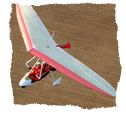| Using the advice I had been given, I immediately opened the throttle to full to get off the ground as soon as possible. We careered down the runway and became airbourne in a much further distance than I had anticipated. The shale runway rushed by underneath us as I lowered the nose to gather airspeed. I hadn't heard any cracks or bangs, and looked up to check the wing was still there and that it didn’t have any rips or tears in it. Spiralling upwards overhead the island, we set off across the water. “G-AZ, you are cleared to climb, not above altitude 5000ft, VFR” Sumburgh boomed across the airwaves.
Their tone was encouraging and at the same time calming, as once more we lost sight of land. It was my first introduction to Class D controlled airspace and being directed in the air.I could hear helicopter traffic being directed out to the oil rigs as we crossed over the 262ft Muskna field hill. Electricity-generating windmills were dotted around the landscape, twirling in the wind, and I realised that it was true; there really were no trees in the Shetlands. The usually strong winds had put a stop to this.
We received a warm reception when we landed at Tingwall. John, the local aircraft engineer was kind enough to let us keep our machine fully rigged next to the resident Islander, tucked away in the corner of the hangar. It was a welcome relief to not have to disassemble the wing for once.That evening we reflected on our adventure over a dinner of fresh Shetland seafood in the highly recommended “Monty’s Bistro” in Lerwick.
FAIR ISLE – TINGWALL (LERWICK) : 13:15 – 14:00
Total Flying: 0:45 minsDAY SEVEN
Surely our luck with the weather would have run out by now? But no, the seventh day of our tour dawned with blue skies and high, wispy cirrus clouds.
We grabbed the opportunity to take what would be an eventful trip around the islands. I hoped we would be able to make our mark and land on Unst, the most Northerly of the islands. I had rung the local council offices the night before to get permission, as the airstrip was listed as being for local ambulance flights only.Working our way Northwards and along the west, we crossed Brae and Yell. As we were overhead Yell, I had yet another new experience. Scatsca asked me to relay a position request to a Danish Navy Helicopter cruising between 2000ft and 500ft; below 2000ft they were unable to contact traffic.“G-AZ, could you ask them if they are flying via Yell Sound or Fetlar?”“Roger, AZ. Will try”I frantically scanned the map to see where the Yell Sound and Fetlar were.
“G-AZ relaying a message for Danish Navy Helicopter, Scatsca would like to know you current position”“Danish Navy, we are passing west abeam Yell, 500ft”.
We lost contact with Scatsca as we descended to land at Unst, but could still hear other aircraft continuing to relay messages.
As we got lower, I realised the wind was considerably stronger on Unst than it had been compared to Tingwall’s 8 knots. The windsock was sticking out horizontally, flailing around and it was 20 knots and another crosswind and as we flared. The front tyre contacted the tarmac, screeching like an airliners.
Very quickly, we decided that we would ditch the idea of a walk around, as I could only just hold wings level in the gusting winds. I checked the fuel and we had just over a quarter of a tank left.
The oil temperature was still at 60oC as we taxied back onto the runway and accelerated. As soon as the wheels left the ground, the trike yawed dramatically into the wind and it was the most unusual feeling. I went with it, still climbing upwards gently. It felt like we were flying a hang-glider as the hill lift pushed us upwards.
Our progress was slow and I was not happy about the fuel situation, especially crossing the sea. Fetlar Island lie ahead and had an airfield but was without a population. This didn’t leave us much chance of getting some fuel. |
|





